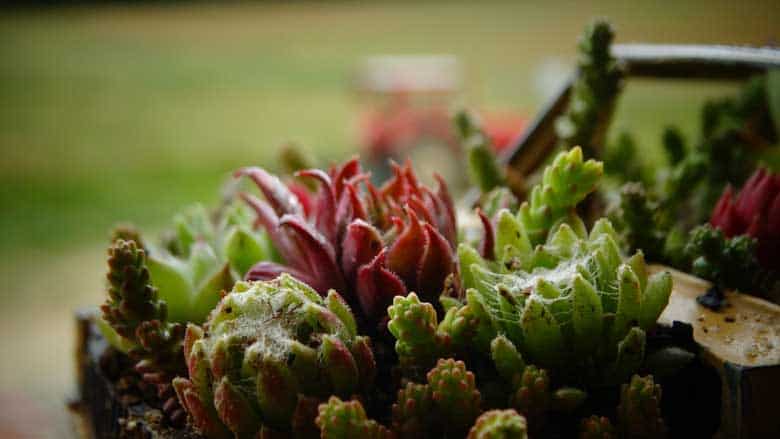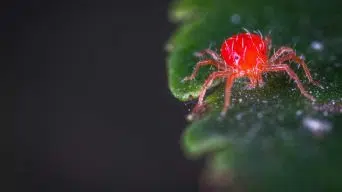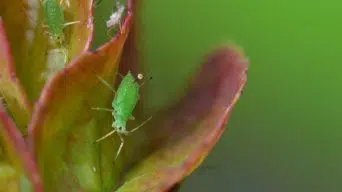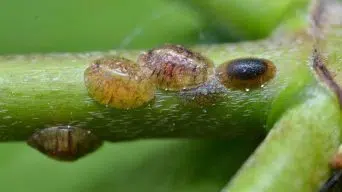Spider mites are tiny pests that damage succulents by feeding on their juices, causing yellowing and webbing. To control them, isolate infested plants, prune affected areas, use insecticidal soap, neem oil, water flushing, alcohol treatment, diatomaceous earth, or beneficial insects. Prevent infestations with good air circulation, proper watering, and regular inspection.
The spider mite is a tiny spider-like critter that feeds on the juices of plants.
It’s not easy to spot, as it’s usually too small for humans to see without a magnifying glass or microscope.
With succulents being so popular, spider mites have been having an easier time finding food sources and reproducing at alarming rates.
In this article, we will go over how spider mites reproduce and find their way onto your succulent plant to provide you with tips on how to get rid of them!
What Are Spider Mites
Spider mites are small, spider-like organisms found worldwide. Despite their eight-legged, spider-shaped appearance, they are not true spiders.
These pests are named for their rapid movement, especially noticeable under a microscope, as they traverse succulent plants.
You can detect these pests by observing tiny dots or white spots on the succulent leaves. These are indications of spider mite eggs, which, if not addressed, quickly develop into more mites.
There’s a variety of spider mite species, but they generally share an oval body and elongated legs.
The two most common types affecting succulents are the two-spotted spider mite, identifiable by its spots, and the plain spider mite, which lacks markings.
A heavy infestation often presents fine webbing around the plant’s leaves or stems.
While this webbing might not always be visible, other detection methods are recommended to confirm their presence.
Spider mites damage plants by piercing and extracting cell contents and injecting toxins.
This action leaves small white or yellow dots on the plants, indicating their detrimental impact.
Causes of Spider Mites Infestation in Succulents
Spider mites are an incredibly common problem for succulents.
They can be caused by spider mite eggs laid on the plant before they become an adult or spider mite larvae that hatch into spider mites after being carried over to another succulent from your houseplants, pets, clothing, etc.
Spider mite populations thrive in hot and dry conditions.
High spider mite populations also occur when there is little to no air circulation, making it even easier for them to spread their spores quickly from one plant to the next.
Spider mites are bugs attracted to succulents with weak immune systems. These pests will appear more often on succulents not receiving enough sunlight or being overwatered.
They are also much more likely to appear if you grow succulents in a humid environment, like inside your home.
How Do I Know if My Succulent Has Spider Mites
Spider mite webbing is the most obvious indicator that your plant has spider mites and should not be ignored.
It will usually look like fine spider webs near where you water your succulents or at the leaf joints (where new leaves emerge).
They are off-white with tiny dots around them – these are eggs that hatch into larvae within hours!
This is why early detection is crucial; if one egg hatches, there could easily be hundreds of these pests on your succulent in a matter of days.
These pests can also be identified by their small spider-like bodies, usually on your plants and not others in your home.
They will live between leaves or under them if there isn’t any webbing yet – so it’s essential to check for them regularly!
Key Signs and Symptoms
Spider mites pose a significant threat to succulents, often indicated by these key signs:
- Spider-like webbing across leaves or between plants.
- Leaves turning yellow or showing discoloration.
- Plant wilting or drooping.
- White spots on leaves.
- Fine webbing on the plant’s soil.
- Leaves falling off.
- Stunted growth of the succulent.
While these pests pose no threat to humans, they can cause significant harm to plants.
If you observe any of the mentioned symptoms on your succulents, carefully examine the leaves and soil for webbing, as this is a key indicator of spider mite infestation.
What Damages Does Spider Mites Cause on Succulents
Spider mites, resembling tiny spiders, inhabit succulent leaves, consuming their tissue.
They pierce cell walls with their mouthparts to extract plant juices, leading to a rapid appearance of a cast, akin to leaf scorch or potassium deficiency symptoms.
However, this process occurs more swiftly than those issues.
As these bugs persist in feeding, they induce yellow speckling on the leaf’s upper surface, eventually turning brown due to chlorophyll loss (the green pigment in plants).
This damage impedes the plant’s ability to transport water, making it highly susceptible to death under additional stress or pressure.
Moreover, these pests can transmit plant diseases, potentially affecting the succulent.
This risk extends beyond succulents to other plants, particularly in outdoor gardens or indoor settings where they come in contact with different plants.
Without proper preventive measures, spider mite infestations are likely.
Effective Treatments for Spider Mites
Several easy and effective methods exist to treat and eliminate spider mites on succulents.
Here are some recommended treatments:
1. Pruning Infected Areas
Pruning infected areas is a crucial step in managing spider mites. It’s a straightforward yet highly efficient approach.
When you spot spider mites signs on your succulents, act swiftly by carefully cutting off the affected leaves.
Dispose of these leaves securely by sealing them in a plastic bag or safely incinerating them.
This proactive measure helps prevent the mites from spreading and causing further damage to your succulents.
2. Using Insecticidal Soap Spray
Insecticidal soap sprays effectively eliminate spider mites from succulents. Creating this spray at home with natural ingredients ensures your plants remain unharmed.
For an organic solution, combine water with a mild dishwashing liquid—avoid antibacterial types—in a container holding five gallons of water.
Apply the mixture generously until it runs off the leaves, or directly target these pests and infested areas using a spray bottle. This approach safely controls the bugs on your succulents.
3. Neem Oil Application
Neem oil, a natural and organic solution, treats spider mites on any succulent plant.
This pesticide-free remedy, safe for pets and family members, contains natural ingredients that target and control spider mite infestations.
Its formulation allows deep penetration into leaf surfaces, eradicating eggs, nymphs, adult mites, and their webs.
However, caution is essential during application, as neem oil should not come into contact with the eyes.
An oil spray is recommended to facilitate even distribution and prevent excessive application.
Careful handling is advised to ensure safe and effective use around areas affected by these bugs.
4. Water Flushing Technique
Eliminate spider mites from succulents by spraying water directly onto the infested areas.
When you detect these pests, promptly flush them off to prevent further damage to your succulents’ leaves.
Use a hose or showerhead to apply a strong jet of water for immediate effect. This method offers a quick and effective way to protect your plants.
5. Alcohol-Based Treatment
Applying rubbing alcohol directly to spider mites offers a simple solution for their removal.
Fill a spray bottle with Isopropyl Alcohol or Rubbing Alcohol and thoroughly mist the plant, paying special attention to the undersides of the leaves.
For this method to be effective, avoiding treating succulents under direct sunlight is crucial. This precaution helps prevent potential damage while ensuring effective spider mite control.
6. Utilizing Diatomaceous Earth
Diatomaceous earth is a highly effective, non-toxic treatment for eliminating spider mites on succulent plants.
To apply, gently sprinkle about two tablespoons around the plant’s base, focusing on areas under the leaves where these pests are frequently observed.
This natural substance functions by abrading the mites’ exoskeletons, leading to dehydration while remaining harmless to the plant.
It’s important to avoid wetting the diatomaceous earth, as moisture reduces its pesticidal efficacy.
7. Employing Natural Predators
Introducing beneficial insects such as ladybugs, green lacewings, and praying mantises is an effective method for controlling pests on succulents.
These natural predators naturally consume spider mites, making them valuable allies in garden maintenance.
To attract these beneficial insects, consider cultivating plants like dill, fennel, clover, and other flowering varieties known for their spider mite-repelling properties
8. Mouthwash Remedy
Utilizing mouthwash as a treatment for spider mites offers a potent solution in pest control for succulents.
To prepare the remedy, simply blend one part of mouthwash with nine parts of water.
Directly spraying this mixture onto the spider mites eliminates them, ensuring your plants remain unharmed.
The efficacy of mouthwash in this context lies in its chemical composition, which targets the mites by either disrupting their digestive systems or causing rapid dehydration.
It’s crucial, however, to exercise caution during application. Avoid disturbing the plants, and ensure they are not exposed to direct sunlight while treating them with any spider mite remedy.
Preventative Measures for Spider Mite Infestations
Prevention is key to protecting your succulents from spider mites. Here’s how to safeguard your plants:
- Indoor Environment: Keep your succulents indoors, in a closed room, to shield them from external pests and insects.
- Adequate Ventilation: Ensure proper airflow in the enclosure where the plants are kept. Spider mites thrive in high humidity, so a well-ventilated environment inhibits their breeding.
- Watering Practices: Water the succulents only when the soil is dry. Overwatering creates a conducive environment for spider mites.
- Quality Soil: Use well-draining, high-quality soil. This helps prevent waterlogging, which attracts spider mites.
- Isolation of Infested Plants: If a succulent is infested, isolate it from other plants immediately. Spider mites spread rapidly and can easily infect nearby plants.
- Regular Inspection: Regularly check your plants for signs of infestation. Early detection is crucial for effective control in gardening.
Remember, once a spider mite infestation starts, it can quickly spread throughout your garden. Frequent inspection and immediate action are essential to keep succulents healthy and mite-free.
Final Thoughts
Spider mites, akin to common succulent pests like mealybugs, aphids, and scale, can be controlled relatively easily as part of regular plant care in your home or garden.
These pests not only mark the appearance of your plants but also drain their vitality. Therefore, it’s crucial to promptly address spider mite infestations on succulents to prevent extensive damage.
Immediate action is vital when dealing with spider mites.
Delaying treatment can exacerbate the infestation, destroying your succulents and potentially spreading the mites throughout your home.
Consistency in preventing and treating spider mites is essential to protect your plants and maintain their health.







